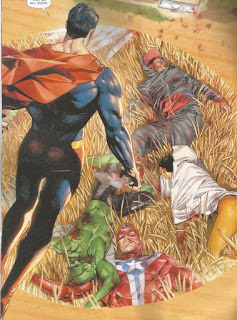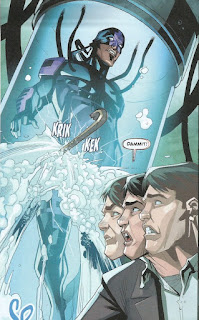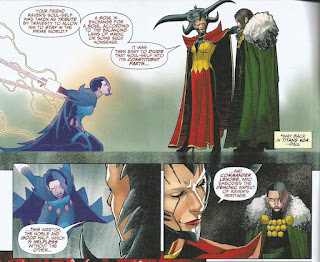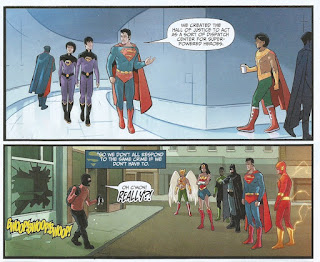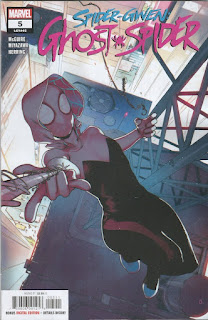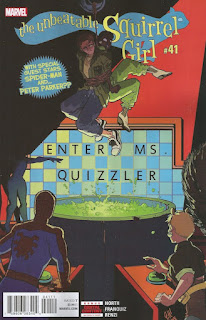Pick of the Brown Bag
February 20, 2019
by
Ray Tate
“Good morning, Mr. Phelps.”
Your mission should you decide to accept it is to read and review the latest issues of Aquaman, Batman, Black Widow, Bitter Root, Exorsisters, James Bond, The Lone Ranger, Nightwing and The Unstoppable Wasp.
We have included additional instructions on Twitter: #PickoftheBrownBag.
“As always, should you or your IMF team be caught or killed the Secretary will disavow any knowledge of your actions. This tape will self-destruct in five seconds. Good luck, Jim.”
Aquaman sails his friend and savior Caille through the rough waters surrounding an island of undetermined origin. This trip is meant to unite mother and daughter, but of course, it's more complicated than that.
Aquaman is not really an Aquaman issue. Our oceanic hero acquires an orange shirt, just a shirt, not chainmail, and saves a life. However, the focus lies on Kelly Sue DeConnick’s rejiggering of world mythology and her likable co-creation Caille No bones to DeConnick, but Caille's body language and expression are notable. Artist Robson Rocha deserves some kudos for giving her life.
Art by Rocha, Daniel Henriques and Sunny Cho on macro and micro level far exceeds DeConnick’s words. Indeed the power in this issue of Aquaman solely arises from the designing of a new pantheon possessing old habits and the visual interaction between Caille and Aquaman.
When I first encountered Caille in DeConnick’s premiere, her name rang bells. I just couldn’t answer. At first I thought she was Calypso, a sea nymph from Homer’s Odyssey. Caille however didn’t sing. She also spoke contemporary English. I next considered that she was an incarnation of the New 52 superhero Pandora.
Unidentified powers appeared to kill Pandora in Rebirth, but she's one of DC's immortals. So, death doesn't necessarily become her. Caille is not Pandora.
DeConnick settles the issue of Caille's identity. The solution isn't surprising. Mainly because the answer comes out of nowhere. There's no fair play involved. In your wildest imaginings, you could not have linked Caille with this figure. Caille's nature is derivative of a pair of 1970s Doctor Who stories. By identifying the stories, you identify Caille and her importance to the Big Bad Namma. So, for those highly curious, drop down to the next depiction of the Aquaman cover for spoilers of the same, Doctor Who and Buffy the Vampire Slayer.
DeConnick settles the issue of Caille's identity. The solution isn't surprising. Mainly because the answer comes out of nowhere. There's no fair play involved. In your wildest imaginings, you could not have linked Caille with this figure. Caille's nature is derivative of a pair of 1970s Doctor Who stories. By identifying the stories, you identify Caille and her importance to the Big Bad Namma. So, for those highly curious, drop down to the next depiction of the Aquaman cover for spoilers of the same, Doctor Who and Buffy the Vampire Slayer.
Tom King's and Joshua Williamson's The Button proves that the Flash and Batman work well together. The Button reveals that they also share some commonalities that the reader may not have thought of before.
The Button's plot is memorable: Batman bests the Reverse Flash; Barry uses the Cosmic Treadmill; both heroes reunite with an old friend neither remembers. Lightning unfortunately isn't striking twice.
The Button took place during a relative calm period in both heroes' lives. The Price occurs during Heroes in Crisis. Batman blames himself for the hero deaths at The Sanctuary, and the Flash doesn't believe he's too far off.
Batman's former protege Gotham Girl fell into crazyland. It appeared Batman repaired her damaged mind, but alas, The Price reveals it ain't so. The Flash wants to know if Batman took Gotham Girl to Sanctuary, and Batman's not fessing up. Is Gotham Girl the murderer? Doubtful. The killer's quiet.
Gotham Girl attacked the Flash Museum. Despite Batman's guilt and the Flash's resentment, the heroes speed to the site and mitigate most of the carnage. They pooled their resources to track down Gotham Girl and uncovered a totally whacked out series of comic book dominoes.
In this issue, Batman and the Flash fight the crazed Gotham Girl, again. The most interesting thing about the rinse, lather, repeat is the return of Batman’s bolo.
The Button's plot is memorable: Batman bests the Reverse Flash; Barry uses the Cosmic Treadmill; both heroes reunite with an old friend neither remembers. Lightning unfortunately isn't striking twice.
The Button took place during a relative calm period in both heroes' lives. The Price occurs during Heroes in Crisis. Batman blames himself for the hero deaths at The Sanctuary, and the Flash doesn't believe he's too far off.
Batman's former protege Gotham Girl fell into crazyland. It appeared Batman repaired her damaged mind, but alas, The Price reveals it ain't so. The Flash wants to know if Batman took Gotham Girl to Sanctuary, and Batman's not fessing up. Is Gotham Girl the murderer? Doubtful. The killer's quiet.
Gotham Girl attacked the Flash Museum. Despite Batman's guilt and the Flash's resentment, the heroes speed to the site and mitigate most of the carnage. They pooled their resources to track down Gotham Girl and uncovered a totally whacked out series of comic book dominoes.
In this issue, Batman and the Flash fight the crazed Gotham Girl, again. The most interesting thing about the rinse, lather, repeat is the return of Batman’s bolo.
Otherwise this chapter reveals nothing, says nothing and exists as vacuole between crossover pieces.
After the events in Batman, Dick Grayson lost his memory and chose to become Ric Grayson. Ric finds another life on the streets of Bludhaven where he ekes out a living driving a cab. Ric frequents the Prodigal Bar where he met and fell in love with bartender Bea. Ric is so determined to start anew that he burned his former headquarters.
Fire only gutted the structure, not the legend. Detective Sapienza investigated the arson, and he found the Nightwing stash that Ric Grayson literally and symbolically tried to burn. Sapienza decided to put the uniforms and equipment to good use. He and a band of fed up public servants became the new Nightwings.
As evinced by his consistently entertaining Red Hood and the Outlaws, Lobdell's strengths lie in comedy, absurdity and action. When watching the detectives, this book is just as good as anything else he has written. He also excels when characterizing special guest Barbara Gordon. Lobdell gets what Robin/Batgirl Shippers fail to see. It’s never going to happen.
In fact, the very thought of such a liaison turned Babs' eyes blue. Correct. Thank you, colorist Tamra Bonnvillain.
Lobdell's romantic scenes however are not all that. These are not the worst amorous moments I’ve read, but they aren't the best. Sometimes painful, mostly dull. Better seen not heard. Travis Moore’s art makes the connections compelling.
As evinced by his consistently entertaining Red Hood and the Outlaws, Lobdell's strengths lie in comedy, absurdity and action. When watching the detectives, this book is just as good as anything else he has written. He also excels when characterizing special guest Barbara Gordon. Lobdell gets what Robin/Batgirl Shippers fail to see. It’s never going to happen.
Lobdell's romantic scenes however are not all that. These are not the worst amorous moments I’ve read, but they aren't the best. Sometimes painful, mostly dull. Better seen not heard. Travis Moore’s art makes the connections compelling.
Then, there’s the Joker’s Daughter. Featured prominently on the cover. Is she really a draw? Are there massive scads of Joker's Daughter fans? I think not.
Originally, Duela Dent, the daughter of Two-Face, adopted the sobriquet to introduce herself to the super-hero community.
She wasn’t a villain, you see. She intended and succeeded to become one of the caped and cowled. Later opting for the code name Harlequin.
I don't get the New 52 version of the Joker’s Daughter, also christened Duela Dent. Lobdell offers no improvement, nor alternative take. He also doesn't adequately explain what the Joker's Daughter is doing here in the first place.
I don't get the New 52 version of the Joker’s Daughter, also christened Duela Dent. Lobdell offers no improvement, nor alternative take. He also doesn't adequately explain what the Joker's Daughter is doing here in the first place.
Taking on the Robber Barons of the West during the Open Range Wars, The Lone Ranger ran afoul of a particularly murderous rancher. An army of ne’er do well cowhands, and a cannibal mercenary backs Mr. Pringle's endeavors to devour territory marked by barbed wire. When last we left the Ranger and Tonto, things didn’t look so good.
What Mark Twain said. The Ranger and Tonto were only playing possum. It will not be the only cleverness seen in this laugh-out-loud conclusion.
In such respect, Mark Russell’s first finale for Lone Ranger agrees with much of the Clayton Moore and Jay Silverheels series. The Ranger wasn’t just the fastest gun. He solved problems with acumen. In Russell's story, The Ranger and Tonto outmaneuver the enemy at every turn. In addition the cattleman’s casual racism is rewarded in spectacular ways. That makes for an outstanding read.
Bitter Root offers a slam-bang issue filled with beautifully constructed monsters and energetically choreographed mayhem. The story so far posits the existence of the Sangereye Family, operating in 1920s Harlem. They're a group of occult trouble shooters, with some leanings toward Doc Savage and his crew of geniuses.
A Big Bad has been monkeying around with science and/or sorcery to infect people, turning them into creatures catalyzed by emotion. Jinoo as they're called are products of hate and racism. For that reason, black folks are immune to Jinoo infection.
However, that doesn't help the heroic and loquacious cousin Berg. Berg seems to be suffering from the same malady. He though still operates on his faculties. So, Berg appears to be something new.
Last issue of Bitter Root introduced the mad Uncle Enoch, master of the slapstick and awfully cute bat bunnies. He teamed up with nephew Cullen.
Enoch names the monsters borne of sorrow and pain. They are the Inzondo. Berg is one of them. Of course, knowing what something is called doesn't actually help the situation, nor close the gates to the nether region that the Big Bad is opening, a fact the returning Ford Sangereye shares in the nick of time.
A Big Bad has been monkeying around with science and/or sorcery to infect people, turning them into creatures catalyzed by emotion. Jinoo as they're called are products of hate and racism. For that reason, black folks are immune to Jinoo infection.
However, that doesn't help the heroic and loquacious cousin Berg. Berg seems to be suffering from the same malady. He though still operates on his faculties. So, Berg appears to be something new.
Last issue of Bitter Root introduced the mad Uncle Enoch, master of the slapstick and awfully cute bat bunnies. He teamed up with nephew Cullen.
Enoch names the monsters borne of sorrow and pain. They are the Inzondo. Berg is one of them. Of course, knowing what something is called doesn't actually help the situation, nor close the gates to the nether region that the Big Bad is opening, a fact the returning Ford Sangereye shares in the nick of time.
James Bond now works with the new South Korean Odd Job John Lee. The edgy alliance brokered by M and his opposite number. Moneypenny serves as the mediator between the egos. Together the team fights ORU. A new organization with a penchant to surgically install kill switches and dopamine rewards in their operatives’ bodies.
A Russian courier in the employ of ORU holds a nuclear bomb in the case handcuffed to his wrist. Bond would like to put a bullet through his skull. John Lee however knows doing so would set off the bomb. So, they must shadow rather than eliminate. The trek takes the agents to a wedding party.
It’s a good if not great issue of James Bond with the introduction of decent new artist Stephen Mooney. The revelations at the end of the chapter are best, but I feel that writer Greg Pak failed to make use of the comedy and romantic potential of the bachelorettes. John Lee’s karaoke being the highlight of the whole affair. I also cannot imagine James Bond saying, “Oh, dear.”
The Soskas' Black Widow is similar to Batman in that the lion’s share is a massive fight. The differences between fights are many.
Whereas Batman and the Flash battle Gotham Girl and her zombie clones, Black Widow viciously duels the pimps of Madripoor.
This isn’t just a show of intrinsic feminism from Natasha. It’s an expression of her rage and the professionalism she seldom can release when battling alongside of the Avengers or Captain America. Even then, because she's classified as dead, Black Widow must team-up furtively.
There are no true consequences in Batman. Nobody in their right mind believes Iris West will buy it at the hands of Gotham Girl.
The working girls of Madripoor however depend on the Black Widow winning her fight. While it’s unlikely the Widow can lose against a bunch of brutal amateurs below her weight class, the stakes are still higher because these non-descript women from a storywriter’s point of view are expendable.
You can create a scenario where somebody pulls out an unexpected weapon to surprise the Black Widow. The girls would suffer in the interim of the Widow’s incapacitation.
Spoiler Ahoy
That doesn’t happen. Instead, the Widow triumphs, and she goes on an information hunting expedition in the seediest of Madripoor’s establishments.
The Soskas very cleverly use the unique nature of comic books to present the passage of time through the depiction of Natasha’s various disguises. Natasha is weaving a web for informants to a snuff movie game involving children.
An abominable subject that fits with the Soskas’ horror film background. They and artist Flaviano surprisingly present this crime in the most tasteful way possible. The imagery nevertheless disturbs as it should.
The fighting in Unstoppable Wasp continues. The bouts as well carry meaning, despite Nadia actually holding back for fear of killing her opponents.
Nadia is beating up her friends. She needs to get back to her miniaturized lab to fix everything that's wrong. Nadia is bipolar like her father Hank Pym, and Jeremy Whitley treats the condition with great respect.
Already, justifiably lauded by The New York Times, Unstoppable Wasp presents a troubled hero with a terrific support team that she pushes away. One of GIRL however will not abandon Nadia.
Priya proves her worth this issue. A shape shifter took her form, and left the group confused. Nadia even classified her as possibly evil when making a list of not just things to fix but also people.
Priya becomes another Wasp to track Nadia down to her lab in the microverse. Time moves differently in that realm, and it's this bonus that Nadia attempted to exploit. Time however gave Nadia time to think and calm down. When Priya reaches Nadia, she's in a dark place.
Priya demonstrates remarkable empathy, which is an unlikely trait to expect if you've been reading The Unstoppable Wasp from the very beginning. In addition to the remarkable portrayal of bipolar disorder, Whitley presses meaning. His point is that you really don't know the inner workings of people, what they've gone through and of what they're capable. Ying is Nadia's best friend, but she chose to protect the rest of GIRL. In the process abandoning Nadia. Priya who seemed to be the most aloof of the group, whose morality became a question when a shape-shifter in the employ of AIM waved good-bye as Priya sticks by Nadia because of personal experience.
Whitley however isn't just after a very special episode of Unstoppable Wasp. The defeat by AIM and their Girl Mercenaries triggered the bipolar flare. The flare instituted a harsh internecine betrayal. That flowed to the riveting discussion and intervention. Priya's attempt to reach the microverse dovetails into Nadia's restored heroism.
Nadia is beating up her friends. She needs to get back to her miniaturized lab to fix everything that's wrong. Nadia is bipolar like her father Hank Pym, and Jeremy Whitley treats the condition with great respect.
Already, justifiably lauded by The New York Times, Unstoppable Wasp presents a troubled hero with a terrific support team that she pushes away. One of GIRL however will not abandon Nadia.
Priya proves her worth this issue. A shape shifter took her form, and left the group confused. Nadia even classified her as possibly evil when making a list of not just things to fix but also people.
Priya becomes another Wasp to track Nadia down to her lab in the microverse. Time moves differently in that realm, and it's this bonus that Nadia attempted to exploit. Time however gave Nadia time to think and calm down. When Priya reaches Nadia, she's in a dark place.
Priya demonstrates remarkable empathy, which is an unlikely trait to expect if you've been reading The Unstoppable Wasp from the very beginning. In addition to the remarkable portrayal of bipolar disorder, Whitley presses meaning. His point is that you really don't know the inner workings of people, what they've gone through and of what they're capable. Ying is Nadia's best friend, but she chose to protect the rest of GIRL. In the process abandoning Nadia. Priya who seemed to be the most aloof of the group, whose morality became a question when a shape-shifter in the employ of AIM waved good-bye as Priya sticks by Nadia because of personal experience.
Whitley however isn't just after a very special episode of Unstoppable Wasp. The defeat by AIM and their Girl Mercenaries triggered the bipolar flare. The flare instituted a harsh internecine betrayal. That flowed to the riveting discussion and intervention. Priya's attempt to reach the microverse dovetails into Nadia's restored heroism.
Exorsisters Cate and Kate Harrow learn of a new threat damaging the balance between heaven and hell.
Boothby already impressed me with the original nature of the sisters. In this issue, he adds another delicate twist. It works to make the magic more palatable to we rational minded readers. It works simply as a nuance and reiteration of Cate's and Kate's origins.
The black goo that flooded Cate's and Kate's office leaves behind a near casualty that demonstrates Cate's and Kate's strong bond. It's rather sweet that Cate comes to Kate's rescue in meaningful gestures of kindness. This balances out Cate's more supernatural gifts to her sister.
As the twins investigate, they become aware of the power behind the shadow. The being corrupts the supposedly incorruptible and resist simple force.
What puzzles me is if the thing is that powerful, why does it offer Cate and Kate a place on his team? Could it be afraid of the Harrows? No. The creature is ready to extinguish the Harrows for good, but because this is magic, it must literally play by the rules. As a result, the shadow-thing eliminates Kate and Cate another way that leads to the amusing cliffhanger.
Boothby already impressed me with the original nature of the sisters. In this issue, he adds another delicate twist. It works to make the magic more palatable to we rational minded readers. It works simply as a nuance and reiteration of Cate's and Kate's origins.
The black goo that flooded Cate's and Kate's office leaves behind a near casualty that demonstrates Cate's and Kate's strong bond. It's rather sweet that Cate comes to Kate's rescue in meaningful gestures of kindness. This balances out Cate's more supernatural gifts to her sister.
As the twins investigate, they become aware of the power behind the shadow. The being corrupts the supposedly incorruptible and resist simple force.
What puzzles me is if the thing is that powerful, why does it offer Cate and Kate a place on his team? Could it be afraid of the Harrows? No. The creature is ready to extinguish the Harrows for good, but because this is magic, it must literally play by the rules. As a result, the shadow-thing eliminates Kate and Cate another way that leads to the amusing cliffhanger.
DeConnick’s Caille is in fact a Celtic goddess, the Cailleach. In Doctor Who, the Cailleach is a long-lived silicon based life form named Cessair of Diplos. The Doctor encounters her in his fourth incarnation.
She is a criminal wanted for grand theft and murder, her tools being the title of the episode “The Stones of Blood.” Great episode. Check it out when you get a moment.
“The Stones of Blood” is one of the stories comprising a rare early Doctor Who arc: The Key to Time. An eternal being known as the White Guardian tasks the Doctor to find the pieces of the Key. Cessair has one and the final piece turns out to be the Princess Astra.
Buffy the Vampire Slayer fans unaware of Doctor Who will no doubt be dumbfounded to learn the history of living keys. Buffy’s sister Dawn Summers was not the first.
So in Aquaman Caille is the Cailleach. She's not so much the child of Namma, rather a piece of her. If you are a long time Doctor Who fan it’s difficult to think of anything else while reading Aquaman. Because of this, DeConnick’s revelations do not seem all that momentous.










